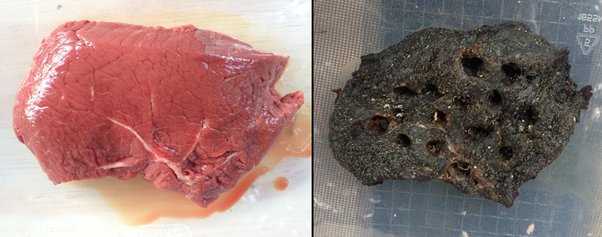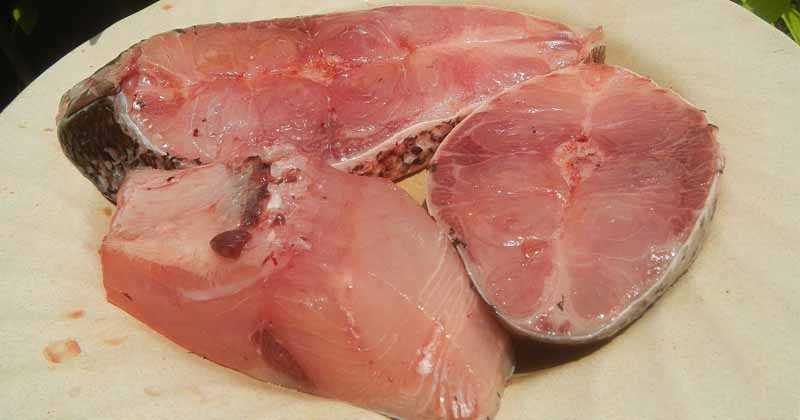When it comes to cooking, one of the most important things to consider is the quality and freshness of the ingredients. But what happens if your meat is spoiled? Can you salvage it by cooking it?
The short answer is no. Cooking spoiled meat will not make it safe to eat. In fact, it can make it even more dangerous to consume. Spoiled meat contains harmful bacteria that can cause food poisoning, such as Salmonella and E. coli. These bacteria produce toxins that can make you sick, and cooking them at high temperatures does not eliminate these toxins.
It is important to note that visual indicators of spoilage, such as discoloration, unpleasant odor, and sliminess, should never be ignored. These are signs that the meat is no longer safe to eat, and no amount of cooking can make it edible again. Consuming spoiled meat can lead to severe stomach cramps, nausea, vomiting, and diarrhea.
Tip: Always practice proper food safety measures by storing meat in the refrigerator at the right temperature, cooking it to the recommended internal temperature, and consuming it within the recommended time frame.
In conclusion, it is crucial to prioritize food safety and avoid cooking spoiled meat. It is better to be safe than sorry and to discard any meat that shows signs of spoilage. Remember to always handle and store meat properly to prevent the growth of harmful bacteria and to keep yourself and your loved ones safe from foodborne illnesses.
Is It Safe to Cook Spoiled Meat?

When it comes to spoiled meat, the general rule is: when in doubt, throw it out. Cooking spoiled meat will not necessarily make it safe to eat.
Signs of Spoiled Meat
Before cooking meat, it’s important to be able to recognize the signs of spoilage. Some common signs of spoiled meat include:
- Unpleasant odor
- Discoloration
- Slime or unusual texture
- Presence of mold or fungus
Dangers of Consuming Spoiled Meat

Eating spoiled meat can result in food poisoning, which can cause a range of symptoms such as nausea, vomiting, diarrhea, and stomach cramps. In some cases, food poisoning can be severe and require medical attention.
When meat spoils, harmful bacteria, such as Salmonella and E. coli, can multiply and produce toxins that cannot be destroyed by cooking. Ingesting these toxins can lead to foodborne illness.
Proper Meat Storage and Handling
To prevent meat from spoiling, it’s essential to store and handle it properly. Some best practices include:
- Refrigerating or freezing meat promptly after purchase
- Keeping raw and cooked meats separate to avoid cross-contamination
- Following recommended storage times and temperatures
- Thawing meat in the refrigerator or using the defrost function on a microwave
By practicing proper food safety techniques, you can reduce the risk of consuming spoiled meat and protect yourself from foodborne illnesses.
Understanding Spoiled Meat
When it comes to cooking, understanding how to handle and identify spoiled meat is extremely important. Consuming spoiled meat can be dangerous and lead to foodborne illnesses.
There are several signs that indicate meat has spoiled. The most obvious one is a foul odor. If the meat smells rancid or different from its usual smell, it is likely spoiled. Additionally, a change in color or appearance, such as a slimy texture or discoloration, can also indicate spoilage.
Types of Spoilage
There are different types of spoilage that can affect meat. Here are a few common ones:
| Type of Spoilage | Description |
|---|---|
| Bacterial Spoilage | Bacteria can multiply rapidly on meat, causing it to spoil. This usually results in a foul odor. |
| Fungal Spoilage | Fungi, such as mold, can grow on meat and produce toxins. This can lead to illness if consumed. |
| Oxidative Spoilage | Exposure to air can cause meat to oxidize and spoil. This can result in a change of color and flavor. |
| Parasitic Spoilage | Parasites, such as worms, can infest meat and cause spoilage. This is rare but can happen if proper hygiene and storage practices are not followed. |
Handling Spoiled Meat
It is crucial to handle spoiled meat properly to prevent cross-contamination and the spread of bacteria. If you suspect that the meat is spoiled, do not taste or consume it. Instead, discard it immediately in a sealed container to contain the odor.
When handling any raw meat, including spoiled meat, it is essential to thoroughly clean any surfaces, utensils, and hands that come in contact with it. Use hot, soapy water to wash and sanitize everything to prevent the spread of harmful bacteria.
In conclusion, understanding how to identify and handle spoiled meat is vital for food safety. By knowing the signs of spoilage and taking proper precautions, such as proper storage and hygiene practices, you can avoid the risks associated with consuming spoiled meat.
Risks of Cooking Spoiled Meat
While it may be tempting to try to salvage spoiled meat by cooking it, doing so can pose serious health risks. Spoiled meat is generally contaminated with bacteria, such as Salmonella, E. coli, and Campylobacter, which can cause food poisoning.
Cooking spoiled meat does not kill all of the bacteria, since their toxins may still be present. Ingesting these toxins can lead to symptoms such as nausea, vomiting, diarrhea, and abdominal pain. In severe cases, it can even lead to more serious illnesses like botulism, which can cause respiratory failure.
Additionally, cooking spoiled meat doesn’t reverse any chemical changes that may have occurred due to spoilage. Rotting meat can release harmful compounds, such as histamine and putrescine, which can also cause illness when consumed.
It’s important to prioritize food safety and discard any meat that shows signs of spoilage, such as a foul odor, slimy texture, or unusual color. Never rely solely on cooking to make spoiled meat safe to eat. Always ensure that the meat you consume is fresh and properly stored to avoid these risks.
Signs of Spoiled Meat
1. Foul odor: One of the most obvious signs that meat has spoiled is a strong and unpleasant smell. If the meat has a pungent, putrid, or spoiled odor, it is best to discard it immediately.
2. Change in color: Another indicator of spoiled meat is a change in color. Fresh meat typically has a bright red or pink color, while spoiled meat may appear gray or greenish. This change in color can be a clear indication that the meat is no longer safe to consume.
3. Slimy texture: Spoiled meat may also develop a slimy or sticky texture. If the meat feels slimy to the touch, it is a sign of bacterial growth and should not be consumed.
4. Mold growth: The growth of mold on meat is a sure sign of spoilage. Mold may appear as green, black, or white spots on the surface of the meat. It is important to note that removing the mold or cutting off the affected area does not make the meat safe to eat.
5. Excessive freezer burn: Freezer burn occurs when meat has been exposed to air in the freezer for an extended period of time. It can cause the meat to become discolored, dry, and develop a tough texture. While freezer burn does not necessarily make the meat unsafe to eat, it can greatly affect the taste and quality.
6. Unusual texture: Spoiled meat may also have an unusual texture. It may feel mushy, slimy, or excessively tough. Any changes in texture should be taken as a warning sign and the meat should be discarded.
7. Expiration date: Checking the expiration date on packaged meat is an important step in determining its freshness. If the meat has surpassed its expiration date, it is safer to assume that it is spoiled and should not be consumed.
It is important to always practice good food safety habits and trust your senses when it comes to assessing the freshness of meat. When in doubt, it is better to be safe than sorry and opt for fresh, properly stored meat.
Proper Handling of Meat
When it comes to meat, proper handling is essential to ensure food safety. Here are some important tips to keep in mind:
1. Storage: Meat should always be stored at temperatures below 40°F (4°C) to prevent bacterial growth. It is best to store raw meat in the coldest part of the refrigerator, usually on the bottom shelf.
2. Separation: It is crucial to keep raw meat separate from other foods, especially those that will be consumed raw, such as fruits and vegetables. This helps to prevent cross-contamination and the spread of bacteria.
3. Thawing: If you plan to cook frozen meat, it is important to thaw it properly. The safest method is to thaw meat in the refrigerator overnight. If you need to thaw it quickly, you can use a microwave or place the meat in a sealed plastic bag and submerge it in cold water, changing the water every 30 minutes.
4. Cooking: It is essential to cook meat thoroughly to kill any bacteria that may be present. Use a food thermometer to ensure meat reaches the proper internal temperature. For example, ground meat should reach at least 160°F (71°C), while whole cuts of beef or pork should reach 145°F (63°C).
Remember, eating spoiled meat can cause foodborne illnesses and should be avoided at all costs. Always follow proper handling techniques and trust your instincts when it comes to the freshness and quality of meat.
Questions and answers
Is it safe to cook spoiled meat?
No, it is not safe to cook spoiled meat. When meat spoils, it can develop harmful bacteria that can cause food poisoning.
What happens if you cook spoiled meat?
If you cook spoiled meat, it may not kill all the bacteria present. This can lead to food poisoning if consumed.
Can you cook spoiled meat to kill the bacteria?
No, cooking spoiled meat will not ensure that all the bacteria are killed. It is best to discard spoiled meat to avoid the risk of food poisoning.
How can you tell if meat is spoiled?
You can tell if meat is spoiled by its smell, texture, and appearance. If it has a foul odor, slimy texture, or a grey or greenish color, it is likely spoiled.
What should I do if I accidentally eat spoiled meat?
If you accidentally eat spoiled meat and experience symptoms such as nausea, vomiting, diarrhea, or abdominal pain, it is best to seek medical attention. Food poisoning from spoiled meat can be serious.
Can you cook spoiled meat?
Yes, you can technically cook spoiled meat, but it is not recommended. Cooking spoiled meat does not make it safe to eat, as cooking will not kill all the harmful bacteria and toxins that may be present. Consuming spoiled meat can lead to food poisoning and other health risks.
What happens if you eat spoiled meat?
If you eat spoiled meat, you may experience symptoms like nausea, vomiting, stomach cramps, and diarrhea. These symptoms are caused by the toxins produced by bacteria in the spoiled meat. In severe cases, food poisoning from spoiled meat can lead to more serious complications and may require medical attention.






